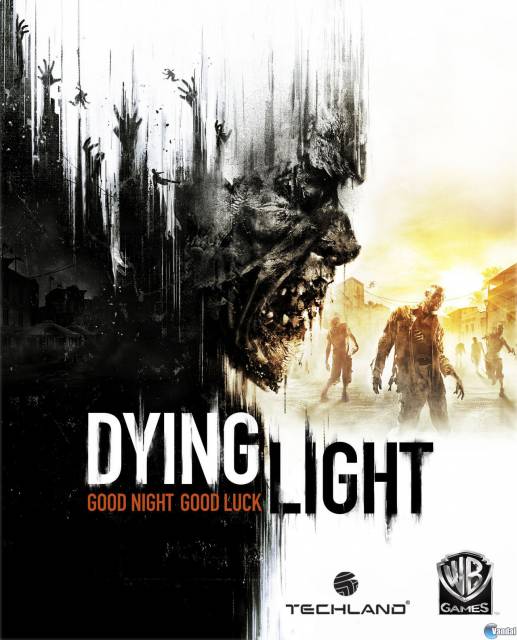A few good ideas don't make this zombie nightmare any less boring
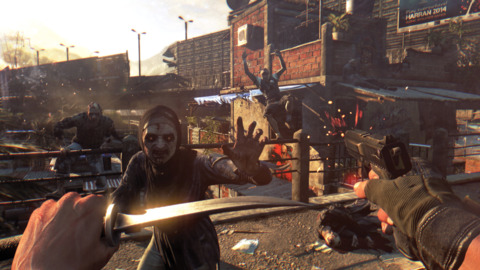
NOTE: I did not engage with the multiplayer--both competitive and co-op--while playing Dying Light, so those elements are not included in the review.
I actively disliked Techland’s previous zombie release, Dead Island. Even as a huge fan of RPG systems and that gameplay style (á la Borderlands), it just rubbed me the wrong way. It felt janky, didn’t offer a compelling story or setting, and was unbearably tedious to push through. When the same company announced a new zombie game with a focus on parkour, I wasn’t really excited. In fact, until it released, I hadn’t seen a moment of its gameplay. Still, like I have with many games before it, I got caught up in the conversation around its release and picked it up (and for only $20, thanks to a Gamestop billing error!). Dying Light managed to pleasantly surprise me in a few ways, but I still think it doesn’t do enough with its concepts.
Dying Light places you into the role of Kyle Crane, an operative of the GRE (Global Relief Effort). After a viral outbreak in fictional city Harran, most of the population are turned into zombie-like creatures of varying types. Crane is airdropped into the city in order to retrieve a sensitive file which contains information that could hurt both Harran’s chances of survival and the GRE’s reputation. Almost immediately, Crane gets bitten and subsequently rescued by residents of the Tower, a local group of survivors banding together to stay alive. He must learn to be a Runner, specialized scouts who use parkour to avoid death and collect supplies, in order to survive. Finding the file will require him to play the various of factions of Harran against each other in order to figure out who has the file and how to recover it without tipping his hand.
The story is neither good or bad: it’s kinda just there. While the voice cast does a decent job with what they’re given, I just had a hard time caring about anything that was happening. You never spend enough time with characters to feel emotional when they inevitably perish. Events are either predictable or laughably convenient. The setting is quite different from your typical zombie story, an old Middle-Eastern themed city, but it lacks the flair and substance that other zombie games have brought to their locals--even Dead Island before it. There are plenty of side quests, sometimes giving unique objectives and telling little stories. Most of them, however, are simple fetch quests with no real story other than “We need this thing. Can you get it?”. For the most part, the story does a good job of keeping you moving from objective to objective, giving you just enough incentive to keep playing without being overly hard to digest. It’s likely that you won’t remember a single character name or detail once you’re done.
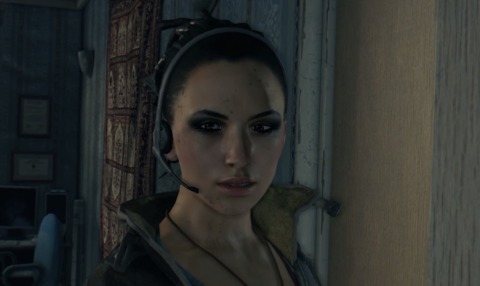
One serious problem the story has is the number of times it contrives situations to leave your character weak and helpless. Your group of survivors has a hard time finding Antizin, the anti-zombie drug necessary to suppress the virus. Since Crane was bitten early in the story, he must deal with debilitating seizures as a side effect of being without the drug for so long. Whenever this happens, the game manifests the seizures by stripping you of all your stamina and slowing your movement down severely. Some of these sections happen back-to-back, leaving you stumbling around a ridiculously slow pace for minutes at a time. Get used to seeing this mechanic, as it happens several times in the back half of the game. It rarely happens anywhere where you’d be in real danger, but it slows the pace of the action to such a crawl that I always resented them.
Dying Light also likes to constantly strip things away from you during set sequences. For example, there are a few places where you cannot use your grappling hook because you are too exhausted, yet your character has no problem parkouring up a building on his own. Boss fights are the most annoying instances of restricting the player. Each of these places you into a locked area, strips away all of your good weaponry and health kits, and forces you through a lengthy fight. Whereas these moments of weakness are justified by the story’s events, it’s frustrating to lose the items and cool gear you’ve earned through your time with the game just because the developers didn’t want to balance bosses around a variety of levels and equipment. Thankfully, these fights are at least generously checkpointed, making it easy enough to try again and persist through the difficulty spike.
The gameplay of Dying Light feels like a natural progression of the original Dead Island, almost as if this were the “real” Dead Island 2. Combat occurs via both melee and ranged weaponry (far more of the prior), using a variety of improvised weapons to bash, slash, or shoot zombies. There’s a kick button, used for crowd control or to knock enemies into obstacles and off roofs. The analog combat and sticky location-based targeting of Dead Island are gone, leaving it to the player to aim his or her strikes for accuracy. Location-based damage is still included, with leg shots toppling zombies more quickly and head strikes giving the most damage. There’s not a lot of strategy to combat: dodging attacks and managing stamina is about all it takes. As such, I never saw the combat as anything but means to an end. When a zombie was in my way, or when a mission required it, I would take them out. Otherwise, I just used the much more enjoyable traversal system to avoid combat entirely.
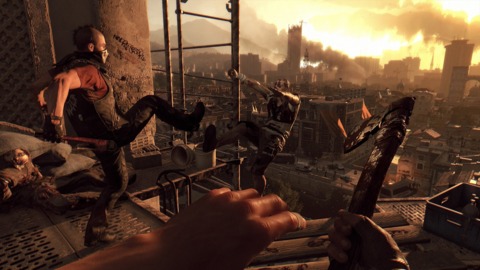
Early on, combat is a decent challenge. Zombies take a lot of damage to finally topple, making even a small number of them dangerous. Your weapons are weak and break easily. Guns are nearly impossible to find. Most terrifying of all are human enemies: they can block (which you can’t), dodge most of your attacks, and like to throw knives and axes at you from a distance. It’s highly advisable to avoid combat with more than one foe early on, especially if they are human. As the game goes on, however, you acquire better weapons and moves, making the combat trivial. Normal zombies fall in just a hit or two, never a threat again. Human foes may be tough in melee combat, but they die instantly with just one shot to the head. Even the bigger, more dangerous zombies are quite manageable on their own after clearing out any other stragglers. It’s a strange difficulty curve, with a very small optimal zone in the middle where the challenge is just right. I passed right over that zone, going straight from combat being a hellacious chore to just being tediously simple. Enemies don’t seem to scale up with your strength, meaning that a late game character will easily walk over most of their foes. Combat just becomes a chore, one I avoided whenever I possibly could and groaned when I was forced into it.
Parkour is something found in many games, but Dying Light does it extremely well. Crane can climb buildings easily and quickly, as long as there are handholds the entire way up. Jump is bound to a shoulder button, making it possible (and necessary) to aim your jumps with precision and while on the move. You have a great deal of mobility, easily sliding through groups of zombies and bounding between buildings whenever necessary. It feels natural and extremely fluid, especially once you unlock a few late-game abilities to smooth out the rough spots: a wall scramble to increase your climbing height, rolling from a drop to avoid fall damage, and even a grappling hook. The grappling hook is a huge game-changer once you unlock it, letting you quickly scale to any grippable surface. It’s a bit buggy, occasionally refusing to grapple or causing the player to not grab the ledge and climb up, but it works well as both a fast escape tool and a way to avoid the tedium of climbing a particularly tall building. I wouldn’t call the traversal the smoothest or best parkour system I’ve experienced game form, but it just felt right, no matter how many hours I spent with it.
As you scale buildings and deal with zombies, you should also keep an eye out for things to scavenge. While you can buy items and weapons from the vendors, it makes far more sense to go out and find them for yourself. There are things to be found everywhere in the world, ripe for the taking. Crafting materials are the most common, letting you put together items like medkits and molotovs. You also find weapons just lying around everywhere, most of which scale up in strength as the game goes on. These can be used in their base state or combined with rarer materials to craft special elemental-based weapons, the strongest weapons in the game. Metal parts can be used to repair broken weapons a set number of times, letting you keep your favorites around a bit longer. There are also valuable items to be found, meant to be sold to a vendor, and weapon upgrade kits which can be slotted into weapons to buff their stats. Chests hold some of the best loot, with a lockpicking minigame straight out of Fallout 3 used to open them; the game is still active while you are doing so, making it a tense affair. To help you find things out in the world, you can use Survivor Sense by holding down the X (A) button, sending out a sonar pulse that highlights interactable objects. This is a habit you should quickly get into, as you will need a plethora of items and weapons in order to make it through the game.
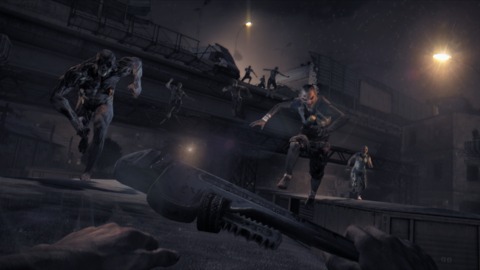
Dying Light, as the name might tell you, makes a big deal about the sun going down. After a certain point in the story progression, night begins to come about regularly. Unlike your typical video game darkness, Harran’s streets get really dark, particularly in areas with no power. Without your flashlight on, it’s fully possible to run look down from a building and be unable to see a thing. To make things worse, extremely aggressive zombies called Volatiles appear. Getting spotted by one makes all hell break loose, essentially forcing you on the run as combat is not really a viable option. This makes night time a more challenging time to scavenge, but there are some huge benefits as well. Supply drops, which happen naturally during your exploration, are quickly snatched up in the daytime hours but left untouched after dark. Those willing to brave the night’s horrors can snag a lot of excellent supplies and bonus XP. Additionally, all of your earned XP is doubled at night, due to the danger of being outside. These bonuses can quickly add up, giving you a huge boost in strength at the cost of a little danger. If this sounds too stressful for you, it’s also possible to head to various safe points and sleep through the nights; aside from a few quests that are done at night, there’s no need to explore in the darkness. I personally loved poking around at night, marvelling at the intense darkness and enjoying the thrills of barely outrunning a vicious pack of Volatiles. It did have the unfortunate side effect of making the daytime, which is much longer, completely rote. Why should I care about slow zombies and no danger when I could instead experience the rush of the nighttime, after all?
Instead of one core level, Dying Light gives you three separate levels and skill trees: your base survivor level, agility, and power. Survivor level goes up from earning XP, which is gotten by completing missions and recovering supply drops from around the city. It’s the most naturally leveling of the bunch, as side quests and main quests give the most Survivor XP and come at an even pace. The tree for Survivor focuses on general perks for your character, such as more slots to carry weapons or the ability to use the grappling hook. Agility level increases as you parkour and platform your way around the city, with every jump and ledge climb adding to the bar. This tree focuses on, as you might expect, better freerunning abilities. These manifest in passive abilities, such as more running stamina, and active abilities, like dropkicks and tackles. Finally, Power level increases with combat, both from individual strikes and kills. The Power tree gives buffs like better weapon durability and new combat abilities to fight with. Both Agility and Power levels can technically be grinded out early on by running around and fighting random zombies, though this would be both boring and time-consuming, as the number of points needed goes up extensively at the higher levels.
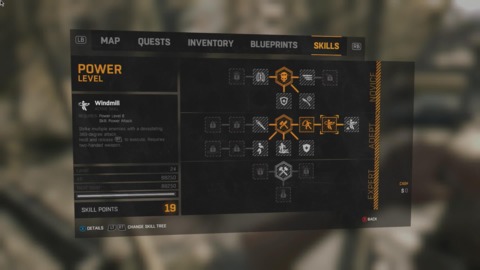
I love any XP system where doing a thing actually makes you better at that thing. It was constantly rewarding to platform my way across the city and gain a new level at the same time, earning a fun new perk to play with. Separating it out this way also made it so I was always close to leveling in one of the three trees, encouraging me to head out and grind the last bit before the next mission. It’s a great system, but it has one major flaw: there’s a big gap in the skill tree. You can reach the bottom of the tree around Level 13-14 in each type. The final skill in the tree requires ALL other points in the tree in order to unlock, unlike the progression before it. These skills are the ones you want, offering things like unlimited stamina for both combat and movement. The only possible way you’ll get enough XP to unlock them, however, is by doing ALL of the content in the game and maybe even grinding a bit in addition. I think I would have preferred if the final skill had been something good, but not great, and been unlockable by the endgame, making the current final point rewards be something that unlocks automatically as you finish the tree. Instead, I just felt like I peaked early on and had nothing to look forward to in any of the trees anymore.
Dying Light does a few things really well. Its parkour system is engaging and entertaining, making it fun to just run around a hostile city. The three skill trees based around earning XP as you do those things are great, incentivizing you towards the playstyle you’re already focusing on. Unlike Dead Island, it is surprisingly bug-free (my playthrough at least). Unfortunately, it just can’t tie everything together. The story is forgettable, the combat is just as boring as Dead Island’s, and there are several odd decisions made by a developer obviously focusing on a narrative experience over gameplay. It’s a game that is far too long, wearing out its welcome by the final hours. On the whole, Dying Light just doesn’t earn its $60 price tag.
